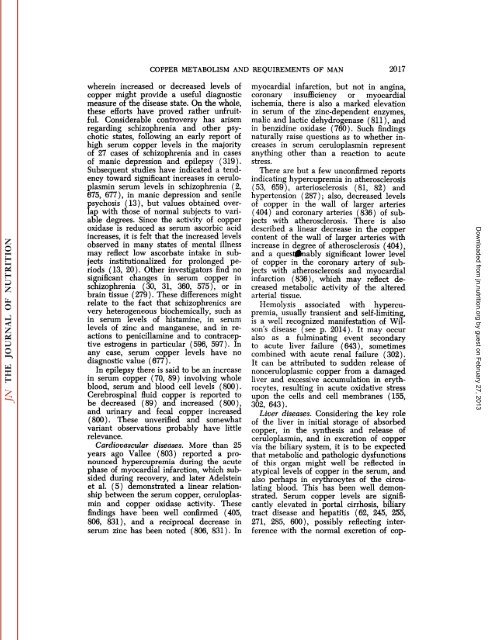conspectus of researchon copper metabolism and requirements
conspectus of researchon copper metabolism and requirements
conspectus of researchon copper metabolism and requirements
Create successful ePaper yourself
Turn your PDF publications into a flip-book with our unique Google optimized e-Paper software.
COPPER METABOLISM AND REQUIREMENTS OF MAN 2017<br />
wherein increased or decreased levels <strong>of</strong><br />
<strong>copper</strong> might provide a useful diagnostic<br />
measure <strong>of</strong> the disease state. On the whole,<br />
these efforts have proved rather unfruit<br />
ful. Considerable controversy has arisen<br />
regarding schizophrenia <strong>and</strong> other psy<br />
chotic states, following an early report <strong>of</strong><br />
high serum <strong>copper</strong> levels in the majority<br />
<strong>of</strong> 27 cases <strong>of</strong> schizophrenia <strong>and</strong> in cases<br />
<strong>of</strong> manic depression <strong>and</strong> epilepsy (319).<br />
Subsequent studies have indicated a tend<br />
ency toward significant increases in ceruloplasmin<br />
serum levels in schizophrenia (2,<br />
675, 677), in manic depression <strong>and</strong> senile<br />
psychosis (13), but values obtained over<br />
lap with those <strong>of</strong> normal subjects to vari<br />
able degrees. Since the activity <strong>of</strong> <strong>copper</strong><br />
oxidase is reduced as serum ascorbic acid<br />
increases, it is felt that the increased levels<br />
observed in many states <strong>of</strong> mental illness<br />
may reflect low ascorbate intake in sub<br />
jects institutionalized for prolonged pe<br />
riods ( 13, 20 ). Other investigators find no<br />
significant changes in serum <strong>copper</strong> in<br />
schizophrenia (30, 31, 360, 575), or in<br />
brain tissue (279 ). These differences might<br />
relate to the fact that schizophrenics are<br />
very heterogeneous biochemically, such as<br />
in serum levels <strong>of</strong> histamine, in serum<br />
levels <strong>of</strong> zinc <strong>and</strong> manganese, <strong>and</strong> in re<br />
actions to penicillamine <strong>and</strong> to contracep<br />
tive estrogens in particular (596, 597). In<br />
any case, serum <strong>copper</strong> levels have no<br />
diagnostic value (677).<br />
In epilepsy there is said to be an increase<br />
in serum <strong>copper</strong> (70, 89) involving whole<br />
blood, serum <strong>and</strong> blood cell levels (800).<br />
Cerebrospinal fluid <strong>copper</strong> is reported to<br />
be decreased (89) <strong>and</strong> increased (800),<br />
<strong>and</strong> urinary <strong>and</strong> fecal <strong>copper</strong> increased<br />
(800). These unverified <strong>and</strong> somewhat<br />
variant observations probably have little<br />
relevance.<br />
Cardiovascular diseases. More than 25<br />
years ago Vallee (803) reported a pro<br />
nounced hypercupremia during the acute<br />
phase <strong>of</strong> myocardial infarction, which sub<br />
sided during recovery, <strong>and</strong> later Adelstein<br />
et al. (5) demonstrated a linear relation<br />
ship between the serum <strong>copper</strong>, ceruloplasmin<br />
<strong>and</strong> <strong>copper</strong> oxidase activity. These<br />
findings have been well confirmed (405,<br />
806, 831), <strong>and</strong> a reciprocal decrease in<br />
serum zinc has been noted (806, 831). In<br />
myocardial infarction, but not in angina,<br />
coronary insufficiency or myocardial<br />
ischemia, there is also a marked elevation<br />
in serum <strong>of</strong> the zinc-dependent enzymes,<br />
malic <strong>and</strong> lactic dehydrogenase (811), <strong>and</strong><br />
in benzidine oxidase (760). Such findings<br />
naturally raise questions as to whether in<br />
creases in serum ceruloplasmin represent<br />
anything other than a reaction to acute<br />
stress.<br />
There are but a few unconfirmed reports<br />
indicating hypercupremia in atherosclerosis<br />
(53, 659), arteriosclerosis (81, 82) <strong>and</strong><br />
hypertension (287); also, decreased levels<br />
<strong>of</strong> <strong>copper</strong> in the wall <strong>of</strong> larger arteries<br />
(404) <strong>and</strong> coronary arteries (836) <strong>of</strong> sub<br />
jects with atherosclerosis. There is also<br />
described a linear decrease in the <strong>copper</strong><br />
content <strong>of</strong> the wall <strong>of</strong> larger arteries with<br />
increase in degree <strong>of</strong> atherosclerosis (404),<br />
<strong>and</strong> a questionably significant lower level<br />
<strong>of</strong> <strong>copper</strong> in the coronary artery <strong>of</strong> sub<br />
jects with atherosclerosis <strong>and</strong> myocardial<br />
infarction (836), which may reflect de<br />
creased metabolic activity <strong>of</strong> the altered<br />
arterial tissue.<br />
Hemolysis associated with hypercu<br />
premia, usually transient <strong>and</strong> self-limiting,<br />
is a well recognized manifestation <strong>of</strong> Wil<br />
son's disease (see p. 2014). It may occur<br />
also as a fulminating event secondary<br />
to acute liver failure (643), sometimes<br />
combined with acute renal failure (302).<br />
It can be attributed to sudden release <strong>of</strong><br />
nonceruloplasmic <strong>copper</strong> from a damaged<br />
liver <strong>and</strong> excessive accumulation in erythrocytes,<br />
resulting in acute oxidative stress<br />
upon the cells <strong>and</strong> cell membranes (155,<br />
302, 643).<br />
Liver diseases. Considering the key role<br />
<strong>of</strong> the liver in initial storage <strong>of</strong> absorbed<br />
<strong>copper</strong>, in the synthesis <strong>and</strong> release <strong>of</strong><br />
ceruloplasmin, <strong>and</strong> in excretion <strong>of</strong> <strong>copper</strong><br />
via the biliary system, it is to be expected<br />
that metabolic <strong>and</strong> pathologic dysfunctions<br />
<strong>of</strong> this organ might well be reflected in<br />
atypical levels <strong>of</strong> <strong>copper</strong> in the serum, <strong>and</strong><br />
also perhaps in erythrocytes <strong>of</strong> the circu<br />
lating blood. This has been well demon<br />
strated. Serum <strong>copper</strong> levels are signifi<br />
cantly elevated in portal cirrhosis, biliary<br />
tract disease <strong>and</strong> hepatitis (62, 245, 255,<br />
271, 285, 600), possibly reflecting inter<br />
ference with the normal excretion <strong>of</strong> cop-<br />
Downloaded from<br />
jn.nutrition.org<br />
by guest on February 27, 2013
















